Kalanchoe Pink Butterflies Care Guide
Written by Iris
Nov 08 2021
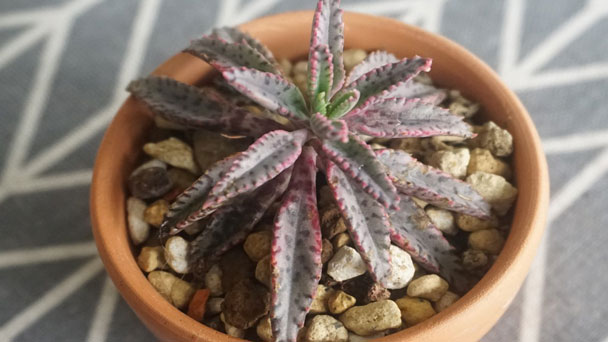
These colorful Kalanchoe Pink Butterflies are real show stoppers. Kalanchoe Pink Butterflies vary in color by leaf with no rhyme or reason. Kalanchoe Pink Butterflies are a lovely cross breed of Mother of Thousands and Kalanchoe tubilflora. Kalanchoe Pink Butterflies do not propagate by leaf. The margins on the leaves of these house many babies, wind knocks them down into the soil and they grow fairly easily from there.
This type of succulent prefers a warm climate. It can survive at zone 9a-11b which is around -6.7 °C (20 °F). If you live in a cold area, it is better to plant pink butterflies in an indoor environment. As long as it gets enough sunlight, the plant will grow happily. When selecting what pot to use be sure that you understand the difference between the material used.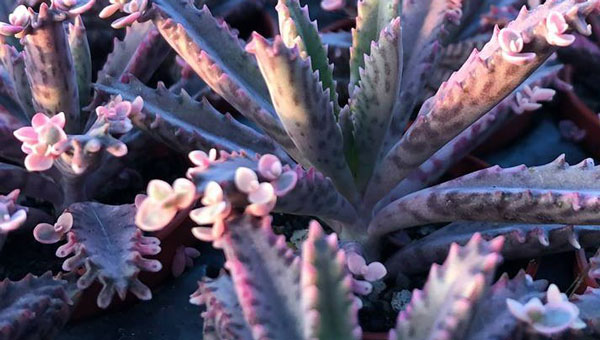
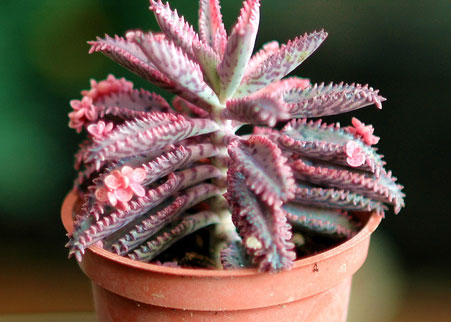
To propagate new Kalanchoe Pink Butterflies, fill the pots with a cactus potting mix. Place the Kalanchoe pink butterflies plant parts at the top of the moist potting soil.
Keep sprinkling water on the cuttings for the first few days to keep the soil and cuttings moist. But make sure do not overwater and also avoid exposure to direct intense sunlight.
Once the plants are established in the soil cut short the water supply and care for them like mature succulents.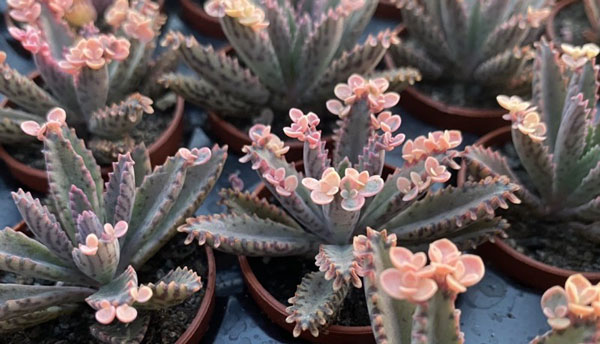
Hardiness zones
Kalanchoe Pink Butterflies is grown as a hardy succulent in USDA hardiness zones 9b to 11b.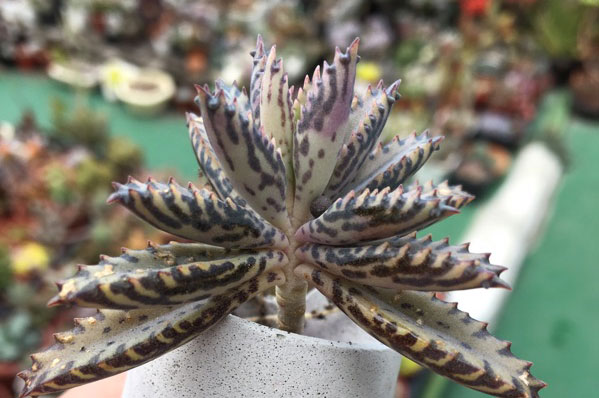
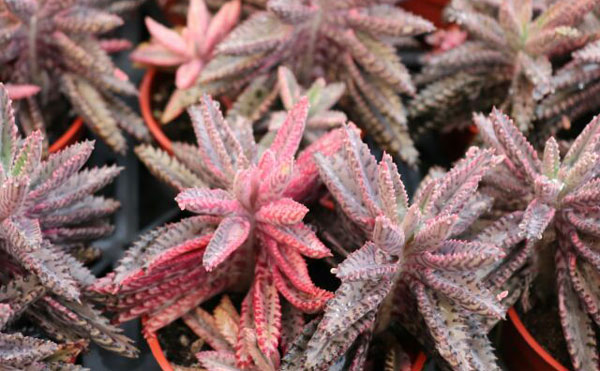
Kalanchoe blossfeldiana: The most popular type of kalanchoe, blossfeldiana features large flower heads and is available in a variety of colors. They naturally bloom in the spring, though they can be forced into flowering throughout the year.
Kalanchoe manginii: This plant varietal features fleshy leaves and bears large, bell-like pendant flowers. Moist air is an essential component of its prolonged flowering.
Kalanchoe porphyrocalyx: Also known as Pearl Bells, this varietal consists of slender, rectangular leaves and purple pendant flowers.
Kalanchoe beharensis: This kalanchoe type is prized for its large, velvety leaves, which come in pale silvery green.
Kalanchoe pinnata: This kalanchoe variety is characterized by fleshy green leaves and bears tiny plantlets along its margins.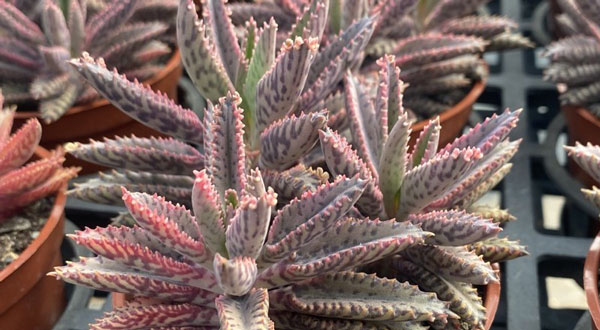
You Kalanchoe Pink butterflies will bloom merrily in the next season. If you follow this practice every year you can force your succulents to bloom for years.
Where to Grow Kalanchoe Pink ButterfliesHow to Grow Kalanchoe Pink ButterfliesKalanchoe Pink Butterflies Propagation with Stem CuttingsKalanchoe Pink Butterflies Propagation with Leaf CuttingsHow to Care for Kalanchoe Pink ButterfliesKalanchoe Pink Butterfly Light RequirementsKalanchoe Pink Butterfly Soil CareKalanchoe Pink Butterfly WateringKalanchoe Pink Butterfly Temperature & Humidity CareKalanchoe Pink Butterfly Fertilizer CareKalanchoe Pink Butterfly Pruning CareKalanchoe Pink Butterfly Pests & Diseases CareVarieties of KalanchoeKalanchoe Pink Butterflies Care FAQIs it an indoor or outdoor succulent?How to make Kalanchoe Pink Butterflies bloom again?Is Kalanchoe Pink Butterflies toxic?
Where to Grow Kalanchoe Pink Butterflies
Kalanchoe Pink Butterflies succulents need strong light. When planting this succulent type in a garden, make sure it gets sunlight. Full to partial sun is the best for its growth. It is better to grow outdoor rather than indoor.This type of succulent prefers a warm climate. It can survive at zone 9a-11b which is around -6.7 °C (20 °F). If you live in a cold area, it is better to plant pink butterflies in an indoor environment. As long as it gets enough sunlight, the plant will grow happily. When selecting what pot to use be sure that you understand the difference between the material used.

How to Grow Kalanchoe Pink Butterflies
Unlike Kalanchoe 'Mother of Thousands' kalanchoe pink butterflies can not be propagated by dropping the leaflets or bulbils directly into the soil. Because the pink bulbils lack chlorophyll. It will not propagate the way a green part of succulent does. Therefore, it is preferable to use leaf and stem cutting for propagating kalanchoe Pink Butterflies.Kalanchoe Pink Butterflies Propagation with Stem Cuttings
Kalanchoe Pink Butterflies are fun to grow from cuttings. The vegetative stems produce the best kalanchoe pink Butterflies plants and root quickest. Take a 2- to 3-inch (5-7.5 cm.) section and strip off the bottom couple of leaves. Let the cutting sit out in a warm, dry location to form a callus on the end. Plant the cutting in pre-moistened peat and perlite up to the first leaf. Enclose the entire pot in plastic to form a little terrarium and conserve the moisture. Place the pot in a bright window with indirect light. Cuttings will root in 14 to 21 days and are then ready to transplant.
Kalanchoe Pink Butterflies Propagation with Leaf Cuttings
To take the Kalanchoe Pink Butterflies leaf cuttings, remove the leaf from the Kalanchoe Pink Butterflies in such a way that it is a clean pull and no part of it should remain attached to the plant. Set aside the cuttings at a warm dry place for a couple of days to develop callous. Avoid keeping the cuttings for too long they will lose all the moisture.To propagate new Kalanchoe Pink Butterflies, fill the pots with a cactus potting mix. Place the Kalanchoe pink butterflies plant parts at the top of the moist potting soil.
Keep sprinkling water on the cuttings for the first few days to keep the soil and cuttings moist. But make sure do not overwater and also avoid exposure to direct intense sunlight.
Once the plants are established in the soil cut short the water supply and care for them like mature succulents.

How to Care for Kalanchoe Pink Butterflies
Kalanchoe Pink Butterfly Light Requirements
Sunlight is the most essential requirement for the growth of Kalanchoe succulents. Kalanchoe Pink Butterflies requires full sunlight to partial shade to grow. Indoor succulents must be kept near a bright sunny south-facing window for 5 to 6 hours a day. You can also keep the potted succulents outside for sunlight exposure in the early morning or afternoon hours when the sunlight is not too intense. Outdoor succulents should be grown in partial shade. Avoid too much exposure to bright direct sunlight it can cause sunscald or burning of leaf tips.Kalanchoe Pink Butterfly Soil Care
Kalanchoe pink butterflies thrives best in well-draining soil. You can use a standard succulent or cactus potting mix that is readily available in the market. Make sure you use pots with good drainage holes to allow the excess water to drain properly. Clay pots are generally recommended because Kalanchoe Pink Butterflies work very well for growing succulents.Kalanchoe Pink Butterfly Watering
Water the Kalanchoe Pink Butterflies succulents growing in the ground approximately once per week, depending on local weather. Water container-grown plants when the soil begins to feel dry. Kalanchoe is relatively drought tolerant but will benefit by occasional watering.Kalanchoe Pink Butterfly Temperature & Humidity Care
Kalanchoe Pink Butterflies prefer to grow at a warm temperature. It can’t tolerate frost. Make sure to pot kalanchoe succulents indoors in those regions where the night temperature goes below freezing. Kalanchoe Pink Butterflies can’t stand freezing temperatures at all. Even a few hours of exposure to below freezing temperatures can easily kill the succulents. If you are growing Kalanchoe Pink Butterflies outdoors make sure to protect them from frost injury by using frost clothes when the temperature goes below freezing.Hardiness zones
Kalanchoe Pink Butterflies is grown as a hardy succulent in USDA hardiness zones 9b to 11b.
- USDA Zone 9b: (25-30 °F) -3.9 to -1.1 °C
- USDA Zone 10a: (30-35 °F) -1.1 to 1.7 °C
- USDA Zone 10b: (35-40 °F) 1.7 to 4.4 °C
- USDA Zone 11a: (40-45 °F) 4.4 to 7.2 °C
- USDA Zone 11b: (45-50 °F) 7.2 to 10 °C

Kalanchoe Pink Butterfly Fertilizer Care
Pink Kalanchoe Pink Butterflies does not require any supplemental nutrients. It gets plenty of nutrients from the potting soil that is sufficient for its normal growth. However, it can get benefit from an extra dose of essential nutrients. You can feed your succulents biweekly with a balanced liquid succulent fertilizer mix.Kalanchoe Pink Butterfly Pruning Care
Pruning Kalanchoe Pink Butterflies is a very simple tasKalanchoe Just take clean gardening shears or scissors and sterilize them by rubbing with alcohol. It will reduce the risk of likely transfer of infection through contaminated tools. Gently remove the unwanted parts of the succulent. Once you are done with pruning discard the removed parts carefully and do not leave your Kalanchoe Pink Butterflies open in the garden soil because they will start rooting.Kalanchoe Pink Butterfly Pests & Diseases Care
Mealybugs and aphids can be occasionally seen attacking Kalanchoe Pink Butterflies. To get rid of these insect pests, rub the parts of this succulent with isopropyl alcohol, or use a neem oil spray. Avoid overwatering because they hate standing in water. Excess of water can cause root rot and encourages fungal growth on the roots.
Varieties of Kalanchoe
While there are tons of different kalanchoe varietals out there, only a few are well-suited to life as a houseplant. The most popular (and widely-available) options include:Kalanchoe blossfeldiana: The most popular type of kalanchoe, blossfeldiana features large flower heads and is available in a variety of colors. They naturally bloom in the spring, though they can be forced into flowering throughout the year.
Kalanchoe manginii: This plant varietal features fleshy leaves and bears large, bell-like pendant flowers. Moist air is an essential component of its prolonged flowering.
Kalanchoe porphyrocalyx: Also known as Pearl Bells, this varietal consists of slender, rectangular leaves and purple pendant flowers.
Kalanchoe beharensis: This kalanchoe type is prized for its large, velvety leaves, which come in pale silvery green.
Kalanchoe pinnata: This kalanchoe variety is characterized by fleshy green leaves and bears tiny plantlets along its margins.

Kalanchoe Pink Butterflies Care FAQ
Is it an indoor or outdoor succulent?
Kalanchoe Pink Butterflies can be grown indoors and outdoors with minimal care and attention.How to make Kalanchoe Pink Butterflies bloom again?
Remove the flower heads or buds at the end of the blooming season. Cut short the water supply for a while. It will allow the plant to rest for some time. Place them in a dark place for 14 hours and 10 hours light.You Kalanchoe Pink butterflies will bloom merrily in the next season. If you follow this practice every year you can force your succulents to bloom for years.
Is Kalanchoe Pink Butterflies toxic?
Yes. All Kalanchoe Pink Butterflies succulents are poisonous to pet cats, dogs, birds, and cattle. This succulent contains cardiac glycosides that can cause health causalities in these animals. The symptoms of toxicity include excessive drooling, diarrhea, stomach upset, changes in heart rate, and rhythm. Keep these succulents away from the access of your pet animals. In case your pet ingests a part of Kalanchoe succulent don't wait for the symptoms to appear. Take it to the Veterinarian immediately for a complete checkup and timely remedy.Latest Updated
- Benefits of Bugleweed - 7 Science-backed Health Benefits
- Bugleweed Dangers & Side Effects - Is It Poisonous?
- How to Plant Evergreen Trees - What You Should Know
- When to Plant Evergreens - Grow Guide for Evergreen Trees
- 12 Wonderful Evergreen Shrubs for Your Garden
- 12 Popular Evergreen Plants with Pictures for Beginners
- When And How To Prune A Lilac Bush Like a Pro
- How to Grow & Care for Lilac Vine (Hardenbergia Violacea)
- Japanese Lilac Tree (Syringa Reticulata) Care & Propagation Guide
- Shumard Oak Pros and Cons - What to Know
Popular Articles
- Winter maintenance of Antirrhinum Majus
- How to Grow Terminalia Mantaly Tree
- How to Grow and Care for Crossostephium Chinense
- How to grow Antirrhinum Majus in spring
- Peristeria Elata (Dove Orchid) Profile: Info & Care Guide
- Underwatered Snake Plant (Sansevieria Trifasciata) - Signs And How To Fix
- How to Care for Brazilian Jasmine Plant (Mandevilla Sanderi)
- How to Grow & Care for Graptopetalum Purple Delight in Summer
- Rosa Chinensis (China Rose): Plant Growing & Care Tips
- How to Care for Baby Sun Rose (Aptenia Cordifolia)